HRK – Croatian Kuna
Effective January 1, 2023, Croatia will be adopting the EUR – European Euro as their official currency. We suggest purchasing Euro for all future travel.
Monetary System
08.07.1941 – 09.07.1945: 1 kuna (KN) = 100 banica
23.12.1991: Croatian dinar (HRD)
30.05.1994: 1 Croatian kuna (HRK) = 100 lipa
Croatian National Bank
Hrvatska Narodna Banka
For more information, visit www.hnb.hr.
2014 Commemorative Issues
This 20-kuna note commemorates the 20th anniversary of the kuna and lipa as Croatia’s currency. It is like the preceding note of the same denomination, but with a block of microtext and a latent image 20 on the watermark area on front.
Description: 20.00 HRK – Croatian Kuna Size: 130 x 65 mm
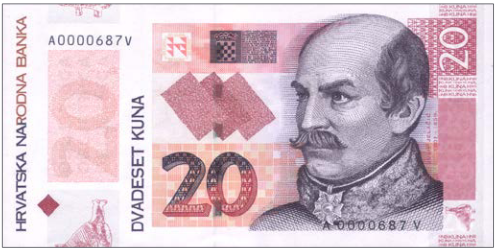
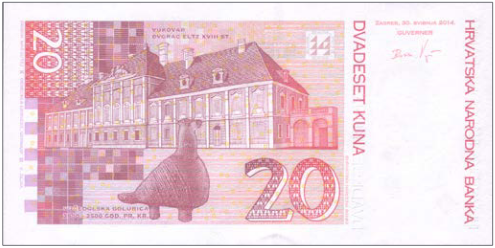
Red. Front: Croatian text; coat of arms; Count Josip Jelačić of Bužim. Back: Croatian text; Dvorac Eltz (Eltz Manor) castle in Vukovar; ceramic Vučedolska golubica (dove from Vučedol). Windowed security thread with demetalized HRK 20. Watermark: Josip Jelačić. Printer: GIESECKE & DEVRIENT, GERMANY. 130 x 65 mm. Paper.
2004 Commemorative Issues
This 10-kuna note commemorates the 10th anniversary of the kuna and lipa as Croatia’s currency. It is like the preceding note of the same denomination, but with a block of microtext and a latent image 10 on the watermark area on front.
Description: 10.00 HRK – Croatian Kuna Size: 126 x 63 mm
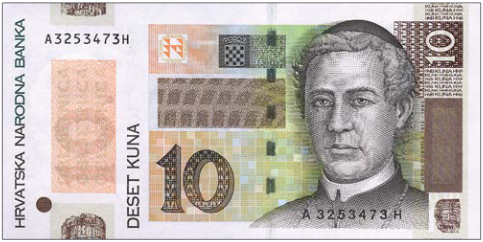
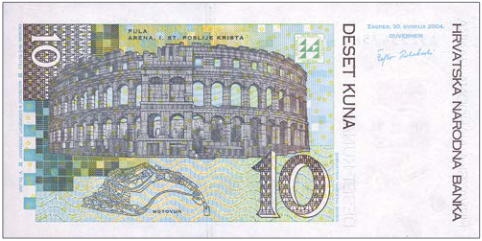
Brown, orange, green, and blue. Front: Croatian text; coat of arms; bishop Juraj Dobrila. Back: Croatian text; Pula arena amphitheater; ground plan of Motovun city in Istria. Windowed security thread with demetalized HRK 10. Watermark: Juraj Dobrila. Printer: GIESECKE & DEVRIENT, GERMANY. 126 x 63 mm. Paper.
2001 – 2012 Issues
These notes are like the preceding issues, but the name of the issuer has changed and security features have been enhanced, including a wider 2.5-mm ClearText windowed security thread, iridescent stripes, latent images, microtext, Omron rings, fragments of architectural vignettes in OVI above and below the watermark area and in the lower right on front. Furthermore, the 50- and 100-kuna notes now have holographic stripes and the 200-kuna note now has a Kinegram.
Description: 10.00 HRK – Croatian Kuna Size: 126 x 63 mm
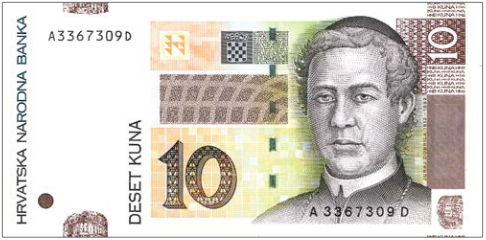
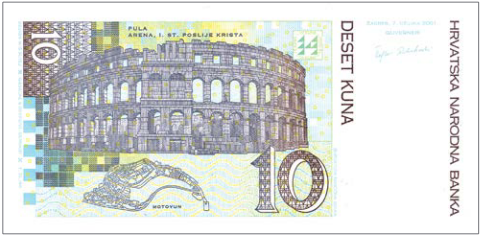
Brown, orange, green, and blue. Front: Croatian text; coat of arms; bishop Juraj Dobrila. Back: Croatian text; Pula arena amphitheater; ground plan of Motovun city in Istria. Windowed security thread with demetalized HRK 10. Watermark: Juraj Dobrila. Printer: GIESECKE & DEVRIENT, GERMANY. 126 x 63 mm. Paper.
Description: 20.00 HRK – Croatian Kuna Size: 130 x 65 mm
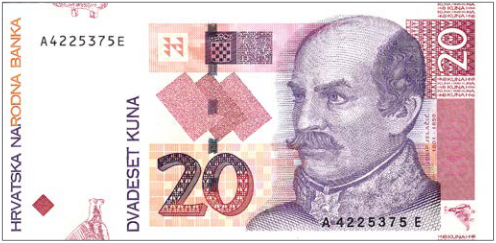
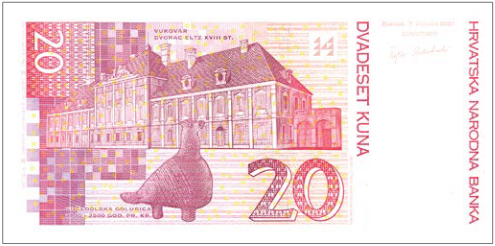
Red. Front: Croatian text; coat of arms; Count Josip Jelačić of Bužim. Back: Croatian text; Dvorac Eltz (Eltz Manor) castle in Vukovar; ceramic Vučedolska golubica (dove from Vučedol). Windowed security thread with demetalized HRK 20. Watermark: Josip Jelačić. Printer: GIESECKE & DEVRIENT, GERMANY. 130 x 65 mm. Paper.
Description: 50.00 HRK – Croatian Kuna Size: 134 x 67 mm
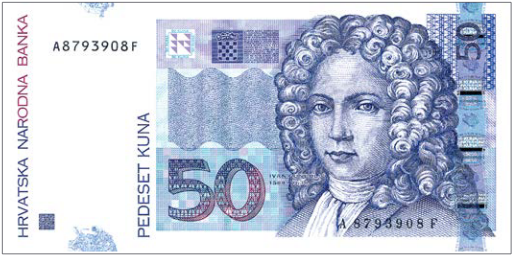
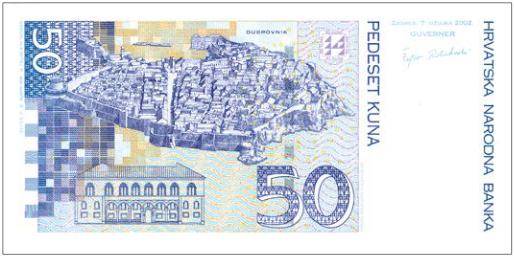
Blue. Front: Croatian text; coat of arms; poet Ivan Gundulić. Back: Croatian text; walled city of Dubrovnik; Rector’s Palace building in Dubrovnik. Holographic stripe. Windowed security thread with demetalized HRK 50. Watermark: Ivan Gundulić. Printer: oebs austria.134 x 67 mm. Paper.
Description: 100.00 HRK – Croatian Kuna Size: 138 x 69 mm

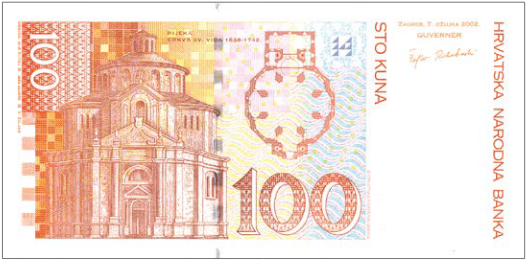
Orange-brown. Front: Croatian text; coat of arms; fragment of the Baska Inscription from the Convent of Saint Lucy in Baska on the island of Krk; poet Ivan Mažuranić. Back: Croatian text; Crkva Sv. Vida (Church of Saint Vitus) in Rijeka; ground plan. Holographic stripe. Windowed security thread with demetalized HRK 100. Watermark: Ivan Mažuranić. Printer: oebs austria. 138 x 69 mm. Paper.
Description: 200.00 HRK – Croatian Kuna Size: 142 x 71 mm
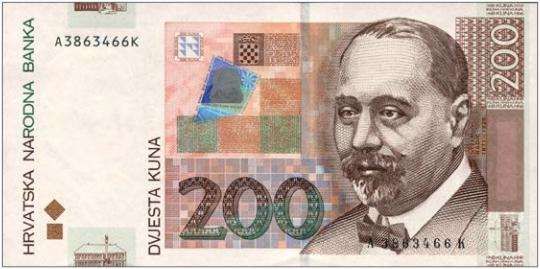
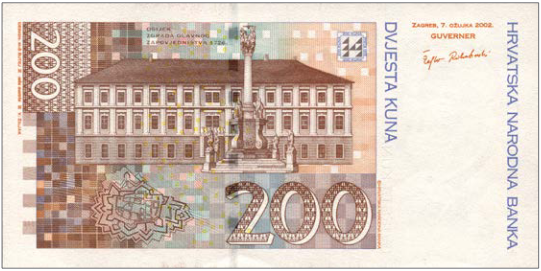
Reddish-brown. Front: Croatian text; coat of arms; quadrangle Kinegram; politician Stjepan Radić. Back: Croatian text; Zgrada glavnog (military command headquarters) building in Osijek; ground plan of old fortress in Osijek; statue. Windowed security thread with demetalized HRK 200. Watermark: Stjepan Radić. Printer: oebs austria. 142 x 71 mm. Paper.
1993 Issues
On 31 May 1994, the kuna was introduced as the monetary unit of Croatia, replacing the dinar at a ratio of 1:1,000. These notes were designed by Miroslav Sutej and Vilko Ziljak, and all feature prominent Croatians on front and architectural motifs on back. The geometric figures at lower left on front (except the 5-kuna note) are intaglio printed for recognition by the sight-impaired. To the right of the coat of arms on front is a microprinted version of the Croatian national anthem, Lijepa Naša Domovino (Our Beautiful Homeland).
Description: 200.00 HRK – Croatian Kuna Size: 142 x 71 mm
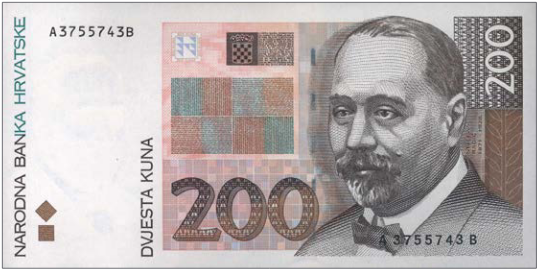
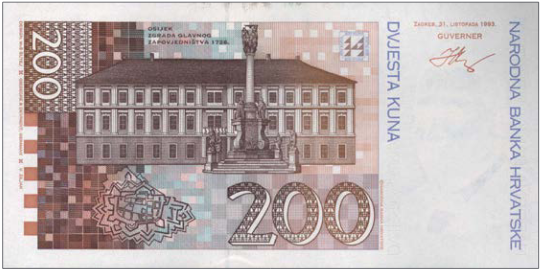
Reddish-brown. Front: Croatian text; coat of arms; politician Stjepan Radić. Back: Croatian text; Zgrada glavnog (military command headquarters) building in Osijek; ground plan of old fortress in Osijek; statue. Windowed security thread with demetalized HK 200. Watermark: Stjepan Radić. Printer: GIESECKE & DEVRIENT, GERMANY. 142 x 71 mm. Paper.
Description: 500.00 HRK – Croatian Kuna Size: 146 x 73 mm
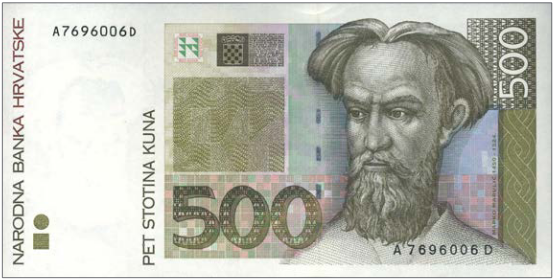
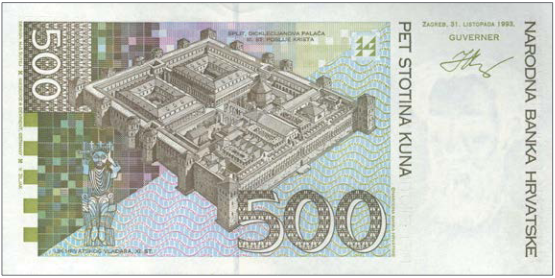
Olive green. Front: Croatian text; coat of arms; writer and humanist Marko Marulić. Back: Croatian text; Lik hrvatskog vladara (figure of 11th-century Croatian ruler); Dioklecijanova Palača (Diocletian’s Palace) in Split. Windowed security thread with demetalized HK 500. Watermark: Marko Marulić. Printer: GIESECKE & DEVRIENT, GERMANY. 146 x 73 mm. Paper.
Description: 1,000.00 HRK – Croatian Kuna Size: 150 x 75 mm

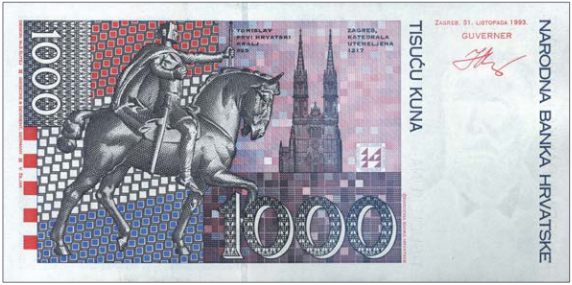
Blue and purple. Front: Croatian text; coat of arms; politician and writer Ante Starčević. Back: Croatian text; equestrian statue of King Tomislav in Zagreb; Zagreb cathedral in Kaptol. Windowed security thread with demetalized HK 1000. Watermark: Ante Starčević. Printer: GIESECKE & DEVRIENT, GERMANY. 150 x 75 mm. Paper.
